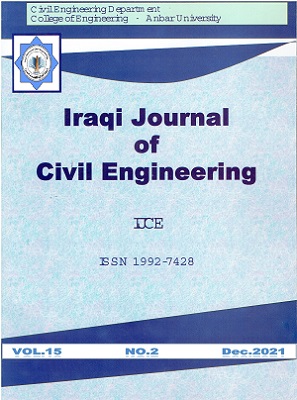Articles in This Issue
Abstract
Ferrocement is a type of concrete made of mortar with different wire meshes. It has wide and varied applications in addition to its strength and durability. This research aims to combine ferrocement and sustainability, as over time, the consumption of plastics, especially plastic bottles, has increased and has serious negative effects if buried, burned, or chemically analyzed. Therefore, this research aims to benefit from this plastic waste and introduce it into the construction field by using plastic waste fibers in the concrete mixture instead of cement at a rate of 0.5% and 1% by volume. This research studied the mechanical properties of nine samples of ferrocement beams with dimensions of 1200 × 200 × 150 mm3. A longitudinal hole with a diameter of 50 mm was drilled in different places of the beams and filled with lightweight concrete to facilitate the use of the hole in service passes when drilled, with a study of the initial cracking loads and the resulting deflection in addition to the failure modes and the deflection resulting from the maximum load. The results showed an improvement in load resistance with an improvement in deflection at the maximum load, In addition to an increase in the improvement of Toughness and Stiffness of ferrocement beams.
Abstract
Land cover assessment is a significant research area in GIS and remote sensing, aiding decision-makers in understanding land use changes' underlying forces and enabling effective actions. In general, Iraqi cities are experiencing severe degradation of agricultural lands due to population growth and residential development, impacting socio-economic and environmental quality. In addition, the deriving forces of transforming the lands from agricultural to other land cover types are not well understood. Research is needed to map and assess agricultural lands for better economic and environmental solutions. The study uses ANN-CA integration to predict agricultural land changes in Babil province, central Iraq. The CNN model achieved the highest accuracy, with a total land cover transformation of 2143.1 square kilometres between 2000 and 2020. the overall accuracy was 0.95, 0.93, and 0.90 based on images captured in 2020, 2000, 2010) respectively. This methodology is considered an efficient tool for monitoring agricultural lands and developing development plans in Iraq.
Abstract
Foamed concrete (FC) is a type of lightweight concrete characterized by a high void space ratio and cementitious binders. In this research, the fresh and mechanical properties of fiber-reinforced modified foamed concrete (made with fly ash, silica fume, and superplasticizer) with a density of 1300 kg/m³ were studied. Carbon fibers of different lengths (12 mm, 20 mm, and 28 mm) were introduced in two ways: as single fibers (12 mm) and as hybrid fibers combining lengths of 20 mm and 28 mm.
The results showed that the compressive and split tensile strengths increased by approximately 43% compared to the control mix (modified with additives) when using a single fiber of 12 mm at a volume proportion of 0.4%. In contrast, using hybrid fibers resulted in increases of about 65% and 66% in compressive and split tensile strengths, respectively. When compared to the single fiber method, the hybrid approach improved compressive and split tensile strengths by about 15% and 16%, respectively.
Abstract
Composite beams, made up of a concrete slab and steel in the IPE steel section, are commonly used in bridges and buildings. Their main function is to enhance structural efficiency by merging the compressive strength of concrete with the tensile resistance of steel, thereby improving overall stiffness, ductility, and load-bearing capacity. This study offers an extensive review of the flexural behavior of steel-concrete composite beams, focusing on the interplay of concrete strength, shear connector types, and interaction levels in determining structural performance. It integrates experimental and numerical research to analyze critical parameters, including load-deflection behavior, shear transfer efficiency, and crack propagation at the steel-concrete interface. The study emphasizes the effect of concrete compressive strength, particularly in ultra-high-performance concrete (UHPC) and lightweight concrete, on stiffness, ductility, and load-bearing capacity while reducing self-weight and enhancing sustainability. The study revealed that fully bonded shear connectors, using CFRP sheets and welded plates, enhance flexural capacity and stiffness. In contrast, partial bonding or pre-debonding reduces performance due to crack propagation. Indented and hot-rolled U-section connectors enhance interaction and minimize slip, while uniform distribution of shear connectors optimizes load capacity and stiffness. Lightweight concrete decreases slab weight without compromising performance, and high-performance materials such as ECC, SFRC, and UHPFRC improve strength and ductility. Numerical modeling, particularly finite element methods, and higher-order beam theories validate experimental results, providing accurate tools for predicting structural behavior under various loading and environmental conditions.
